A Guide to the Types and Uses of Wheat: From Whole Grains to Flour
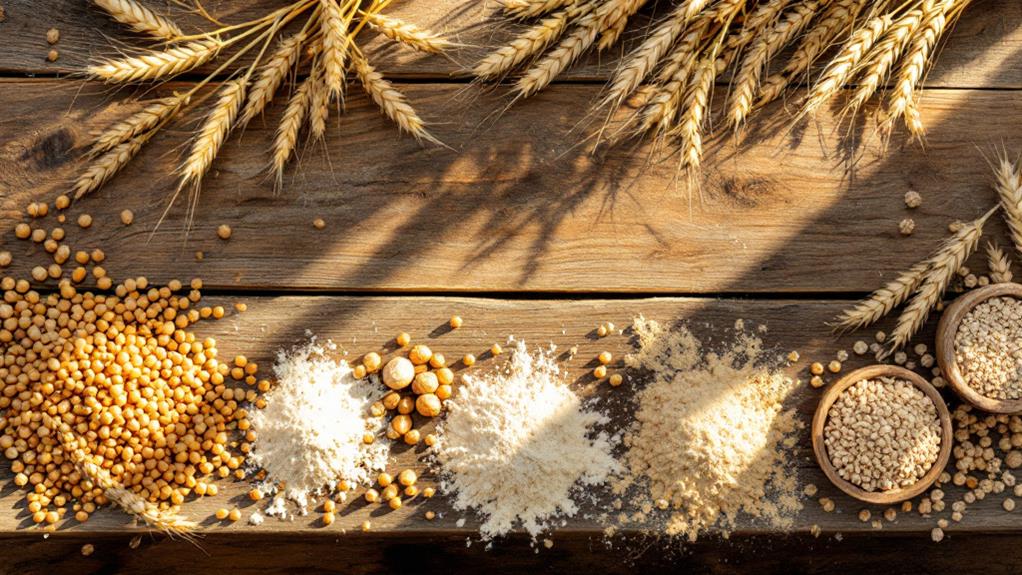
When exploring wheat, you'll encounter six main types, each perfect for diverse baking needs. Hard red wheat is ideal for hearty whole grain bread, while soft wheat excels in pastries. Hard white offers versatile flavor profiles, and durum shines in pasta. Whole grain flours, packed with fiber and nutrients, improve any baked good's heartiness. Consider adjustments when substituting whole wheat flour for lighter results. Understand the wheat berry's layers—bran, germ, and endosperm—for its nutritional punch. The milling method, regardless of stone or roller, impacts the end product's quality. Uncover what makes different whole grain flours and gluten essential in baking.
Understanding Wheat Varieties
When you start investigating the world of wheat, you'll find that it's divided into six major types, each with unique characteristics tailored to different baking needs. Among these, hard red wheat stands out due to its high protein content, ranging from 11-15%. This makes it perfect for baking whole wheat bread, as its strong gluten content supports the bread's structure. On the other hand, soft wheat, with its lower protein content of 5-9%, is ideal for creating delicate pastries and cakes where a tender crumb is desired.
Hard white wheat offers a milder flavor and lighter color, making it versatile across numerous baked goods, from yeasted breads to cookies. It provides a balance between protein content and flavor, which can be advantageous for bakers looking to diversify their recipes. Durum wheat, the hardest of the wheat varieties, is renowned for its role in pasta production. Its high protein content and unique gluten properties are what give pasta its firm texture.
When whole grains are used, the flour milled retains more nutrients, offering different textures and flavors. Understanding these wheat varieties helps you choose the right flour for your baking needs.
Whole Grain Flour Benefits
As you investigate the benefits of whole grain flour, you'll uncover it's packed with nutrition because it retains all parts of the wheat berry—bran, germ, and endosperm. This retention guarantees a higher nutritional value compared to refined flours, which lose critical components. Whole grain flours are rich in fiber, vitamins, and minerals, which support better digestive health and help reduce the risk of chronic diseases.
The fiber content in whole grain flours not only improves your health but also increases satiety, keeping hunger at bay and aiding in weight management. This makes it a wise choice for those looking to maintain a healthy diet. Additionally, the unique flavor and texture that whole grain flours bring to baked goods provide a heartier taste, adding depth to your culinary creations.
When baking with whole grain flour, you'll notice its greater absorbency. It often requires adjustments, like adding extra liquid or allowing the dough to rest, to achieve peak results. These simple tweaks guarantee your baked goods turn out perfectly. Embracing whole grain flours raises both the nutritional profile and the deliciousness of your homemade treats.
Exploring Whole Wheat Flour
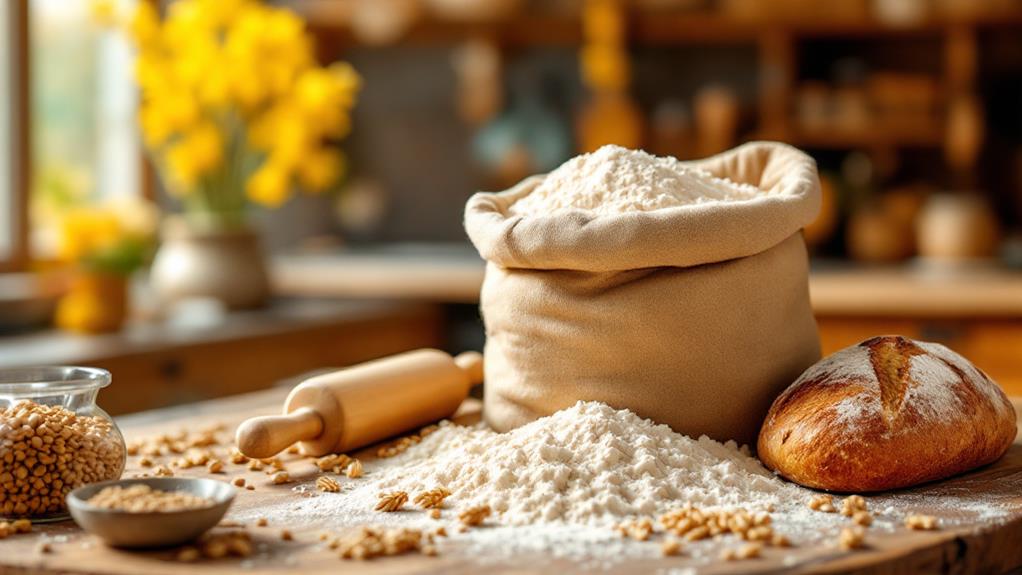
Building on the benefits of whole grain flour, whole wheat flour stands out as a nutritional powerhouse. Made from the entire wheat kernel, including the bran and germ, it retains vital nutrients and fiber often lost in refined flours. This makes it a healthier choice for your baked goods. Primarily derived from hard red wheat, whole wheat flour boasts a protein content of 11-15%, which contributes to its hearty flavor and denser texture. You'll notice this difference in breads, muffins, and cookies, where the flour's robust nature shines.
There are variations to investigate, such as white whole wheat flour, milled from hard white wheat. It offers a milder flavor and lighter color, while still providing the nutritional benefits you seek. This makes it an excellent choice if you prefer a subtler taste in your recipes.
Whole wheat flour is incredibly versatile, ideal for a wide range of baked goods. You might need to tweak recipes slightly, as substitutions could require more liquid or rest time for dough. Despite these adjustments, the improved flavor and nutrition make it a worthwhile supplement to your kitchen arsenal.
Substituting Whole Wheat Flour
Although whole wheat flour can be a nutritious substitute in your baking, it requires some adjustments to get the best results. When substituting whole wheat flour in your recipes, start with a 1:1 ratio, but don't forget to modify the liquid. Add about 2 teaspoons of liquid per cup of whole wheat flour to account for its higher absorption rate. This guarantees your dough doesn't end up dry and crumbly.
For lighter baked goods like cakes and muffins, try using white whole wheat flour or whole wheat pastry flour. These varieties provide a milder flavor and finer texture, making them ideal for delicate recipes. When using whole wheat flour in cookies and quick breads, you'll enjoy a nutty flavor that elevates the nutritional profile of these treats.
If you're making bread, consider blending whole wheat flour with bread flour. This combination improves gluten development, resulting in better rise and texture. Allow your whole wheat dough to rest for at least 20 minutes before baking. This resting period enhances moisture retention and aids in gluten development, giving you a more balanced structure in your final product. With these tips, substituting whole wheat flour becomes a rewarding experience.
Diverse Whole Grain Flours
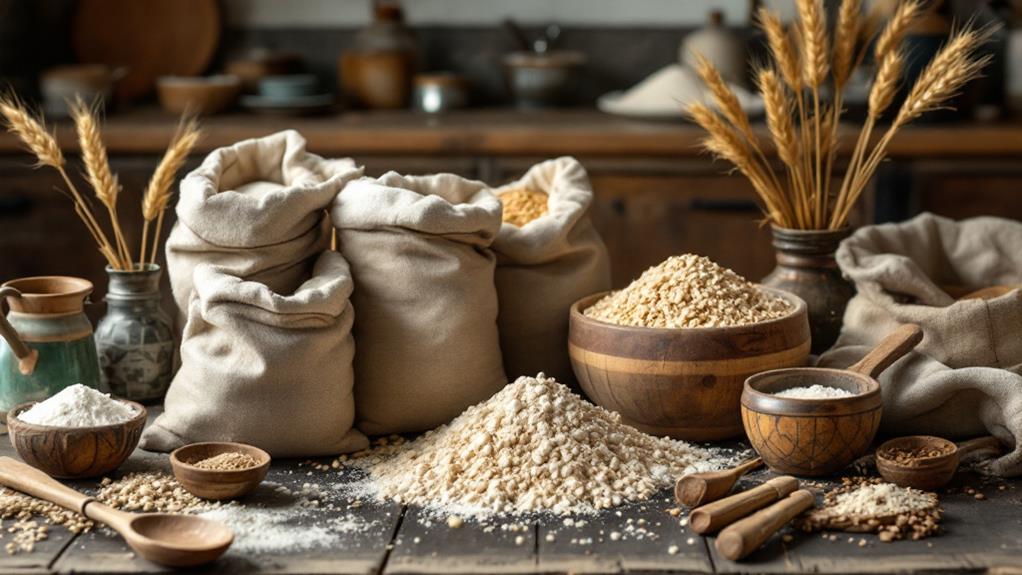
Whole grain flours often bring a rich depth of flavor and nutrition to your baking, thanks to their retention of the entire grain kernel—bran, germ, and endosperm. This retention improves their nutritional profile, making them a healthier choice compared to refined flours. Common types include whole wheat flour, sprouted whole wheat flour, white whole wheat flour, and whole wheat pastry flour, each offering unique flavors and textures. For instance, sprouted whole wheat flour adds a slightly sweeter taste, while white whole wheat flour provides a milder flavor and lighter texture, perfect for those who prefer subtler flavors in their baked goods.
Diving into specialty whole grain flours like spelt, rye, and millet, you'll find distinct taste profiles and sometimes easier digestibility compared to conventional wheat flours. These can transform your recipes with new, exciting flavors and textures. When substituting whole grain flours, adjust the liquid content and allow the dough to rest for ideal moisture retention and texture. For gluten-free baking, investigate flours like buckwheat and quinoa, which offer alternative flavors and nutritional benefits. Welcome the versatility and richness whole grain flours bring to your culinary creations, improving both taste and health.
Wheat Berry Structure
Understanding the structure of a wheat berry is fundamental for appreciating the nutritional differences between whole and refined flours. A wheat berry is composed of three key parts: the bran, germ, and endosperm. The bran, which makes up 13% of the wheat berry, is rich in fiber and minerals. It contributes a brown color to whole wheat flour and supports heart health. Including the bran in your diet guarantees you're getting a good dose of vital minerals and fiber.
The germ is the nutrient powerhouse, even though it only accounts for 3% of the wheat berry. It's packed with fats, proteins, vitamins, and adds flavor. Eating whole wheat flour means you're benefitting from the germ's nutrients, which are critical for general health and energy.
The endosperm, making up 84% of the berry, is mainly starch and protein. It provides the light color and bulk in refined flour. However, refined flour includes just the endosperm, leading to a significant loss of nutrients and fiber compared to whole wheat flour.
The Milling Process
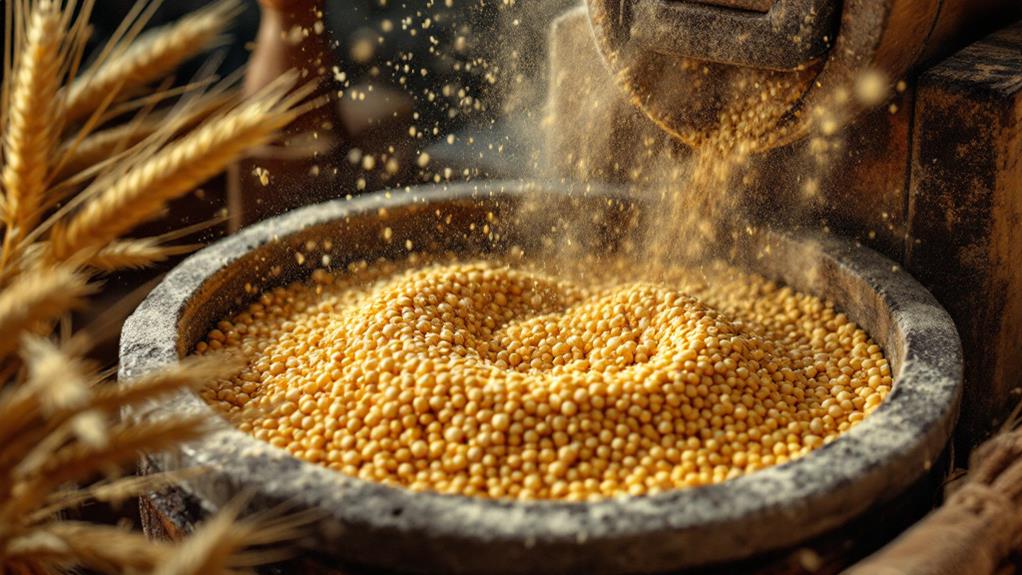
With a solid grasp of the wheat berry's structure, you can now appreciate the intricacies of the milling process. It begins by adding moisture to wheat berries, toughening the bran and softening the endosperm, setting the stage for efficient grinding. The berries are ground and sifted through multiple stages to separate the endosperm from the bran and germ, producing different flour grades.
In the milling world, two primary methods exist: stone milling and roller milling. Stone milling grinds whole grains, preserving nutrients from the bran and germ. However, it's less common due to the efficiency offered by roller milling. Roller milling uses electricity and produces four edible flour streams, including patent flour, which is the highest quality, free of bran and germ. On the other hand, clear flour, containing more bran, is often used in whole grain breads.
Whole wheat flour stands out by combining the ground bran, germ, and endosperm, offering a richer nutritional profile. In contrast, refined flours like all-purpose flour only contain the endosperm and often undergo enriching and bleaching processes to improve their baking qualities. Understanding these distinctions helps you choose the right flour type for your culinary needs.
Gluten's Role in Baking
Gluten, a key protein in wheat, is what gives baked goods their structure and elasticity. When you mix wheat flour with water, gluten proteins form a network. This network traps air bubbles produced during yeast fermentation, giving your bread its light texture. The protein content varies among wheat types, with hard wheat having higher levels, between 11-15%. This makes it perfect for yeast breads that benefit from strong gluten development.
When working with different flours, consider these factors:
- Protein Content: High protein content in wheat flour is vital for creating the strong gluten network needed in yeast breads.
- Hydration: Adjusting hydration levels is significant, especially when using whole grain flours, which can absorb more water due to their fiber content.
- Fermentation: This process improves gluten properties by breaking down complex sugars, enhancing the dough's rise and texture.
- Flour Type: Whole grain flours, with bran and germ included, may result in denser baked goods, requiring longer resting times for proper gluten development.
Yeast Recipes and Tips
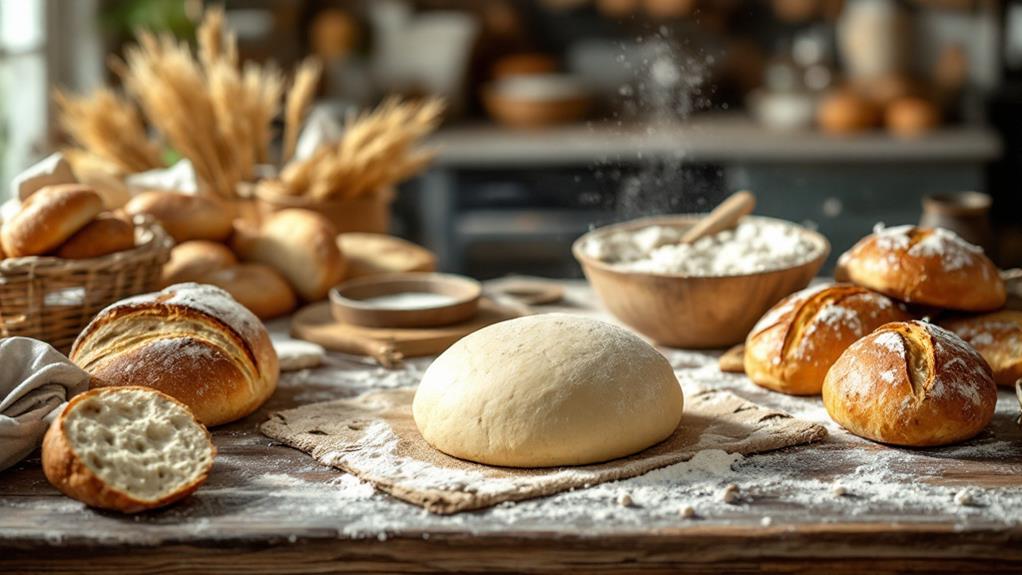
Exploring yeast recipes opens up a world of delicious possibilities, where the right combination of ingredients and techniques can transform simple dough into a masterpiece. Start with the basics: flour, water, yeast, and salt. The key to great bread lies in understanding yeast and fermentation. Warmer environments speed up yeast activity, allowing your dough to rise more quickly and develop flavor. However, don't rush the process; longer fermentation times, like those in sourdough recipes, can improve flavor complexity and yield a robust texture.
Selecting the right flour is essential, too. A mix of whole wheat and bread flour is ideal. The whole wheat adds depth of flavor, while bread flour's higher protein content provides the gluten structure necessary for rising. This combination is perfect for achieving the desired texture in your bread.
When choosing yeast, know that active dry, instant, and fresh yeast can be used interchangeably, though each has unique hydration and activation needs. Adjust according to your recipe's requirements. With these tips, you'll master baking bread that's not only flavorful but also perfectly textured, making each loaf a reflection of the wonders of fermentation and gluten.




